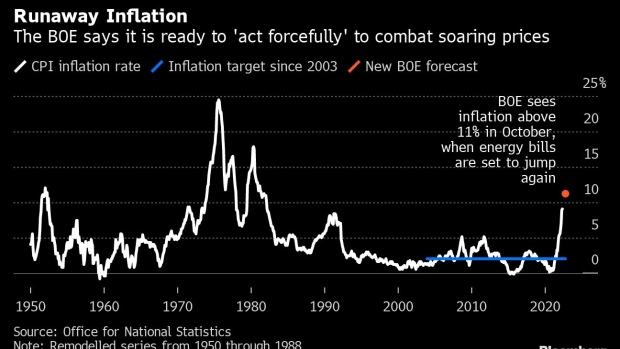Jun 27, 2022
UK Would Have to Pay £14 Billion to Give Public Sector 7% Raise
, Bloomberg News

(Bloomberg) -- The UK government would have to pay £14 billion pounds ($17 billion) a year to give public-sector workers the 7% pay raise that some of them are demanding.
The figures, from an analysis by Bloomberg Economics, shed light on the options Prime Minister Boris Johnson is facing to defuse the biggest round of strikes in decades.
Rail workers and criminal barristers walked off the job in the past week to press for higher pay after inflation hit a 40-year high, and professions from teachers to local authority workers are threatening to do the same.
Johnson had urged departments to be cautious with pay increases to avoid triggering a wage-price spiral. But the issue isn’t likely to go away, with the Bank of England predicting price increases will accellerate past 11% later this year.
Rail workers who crippled public transport for much of last week are seeking a 7% pay increase. The Bloomberg report by analysts Jamie Rush and Dan Hanson suggests that meeting those demands with an increase for all of the UK’s public sector workers would cost less than the cost of the government’s recent package of measures to protect consumers from higher energy bills.
Read More: UK INSIGHT: Cost of 7% Public Sector Pay Bump? 190,000 Jobs
Despite their call for restraint in wages, the government is sticking with plans to increase the state pension in line with inflation next year. Increasing the value of those payments by 10% next year would cost £10.5 billion, the BE analysis showed.
Chancellor of the Exchequer Rishi Sunak has said that situation is different because “pensions are not an input cost into the cost of producing goods and services we all consume, so they don’t add to inflation in the same way.”
Still, some economists have countered that by pointing out the pay for UK teachers, nurses and doctors also don’t form an input cost. The services they provide are free at the point of use, which reduces the risk of a wage-price spiral.
A 7% hike for the more than 5 million workers employed by the state would cost about £8 billion more than the 3% increase that forms the top end of the government’s previous guidance, according to BE. If departments reduce to headcount to cover the cost of the increase, it would lead to 190,000 fewer extra workers being added to the payroll over the next five years, BE said.
©2022 Bloomberg L.P.






